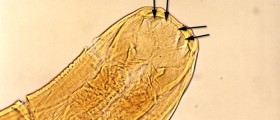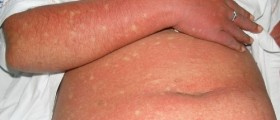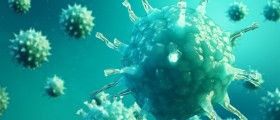
Cysticercosis is a serious tissue infection caused by the pork tapeworm (Taenia solium). Infestation with the parasite typically leads to its spread to many different tissues in the body. The parasite finally ends up in the central nervous system, skeletal muscles, eyes or under the skin. In the affected organs and organ systems the parasite is in a form of special cysts called cysticerci.
The condition may be asymptomatic or cause different symptoms depending on the number of cysts and their location.
This parasitic infection is common for many countries of the developing world. However, due to increased immigration from endemic countries, the incidence of infestation with Taenia solium has increased in the United States. It is estimated that around 1,000 new cases are reported every year.
Transmission of the Parasite
Eggs of the parasite are ingested and they hatch inside the gastrointestinal tract. What follows is penetration of embryos through the intestinal wall and they enter the bloodstream. The parasite spreads to different parts of the body and once it has reached its final destination (whether it is a skeletal muscle, the central nervous system or other organ) it transforms into the cystic form.
Humans are carriers of Taenia solium and they can be asymptomatic carriers. This way the eggs of the parasite are periodically shed together with feces and may contaminate water or different foods. This way infection can be easily spread to animals such as pigs. Now, when pigs get infected, they become a sources of infection as well and can be responsible for further transmission, particularly if one consumes undercooked pork or products made of raw pork. This way the cycle of the parasite becomes complete.
Prevention of Cysticercosis
This parasitic infestation can be prevented with certain measures of precaution. It is essential to be well-educated regarding the parasite and the ways of its transmissions. Furthermore, one should avoid consuming raw or undercooked pork, especially in endemic countries. Transmission can be prevented with proper hygiene measures (hand washing, impeccable personal hygiene and preparation of food under hygienic conditions). It is also important to perform meat inspection and to adequately dispose meat (particularly the infected meat) in endemic countries and areas. And finally, by improving sanitary measures in endemic countries it is possible to reduce the overall number of new cases of cysticercosis.Treatment for Cysticercosis
Once the condition is confirmed, it can be treated with different drugs. Although it is not possible to remove already formed cysts it is essential to bring the existing symptoms under control. Patients can be administered anthelmintics, corticosteroids, anticonvulsants and many other medications which predominantly depends on the locations of cysts and symptoms they are causing.















_f_280x120.jpg)

Your thoughts on this
Loading...